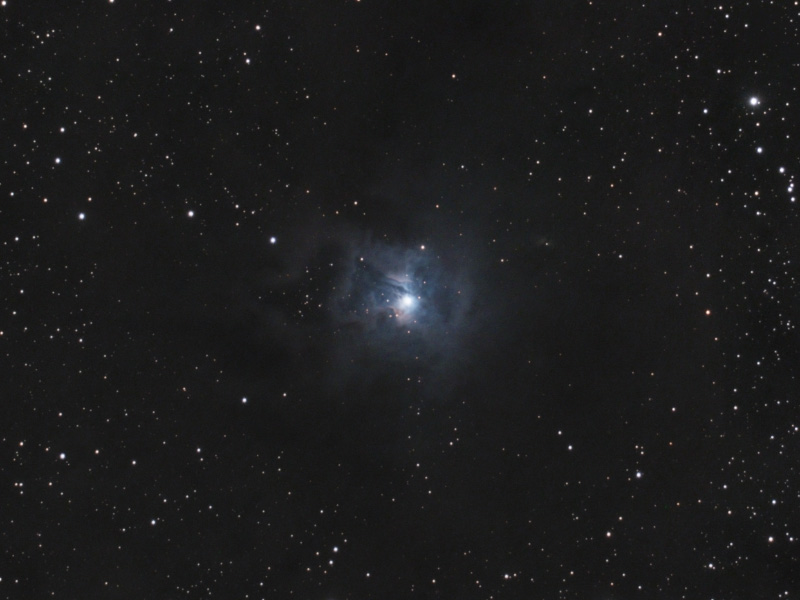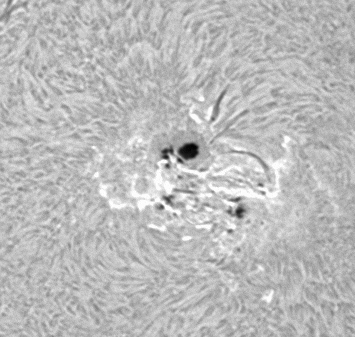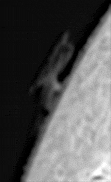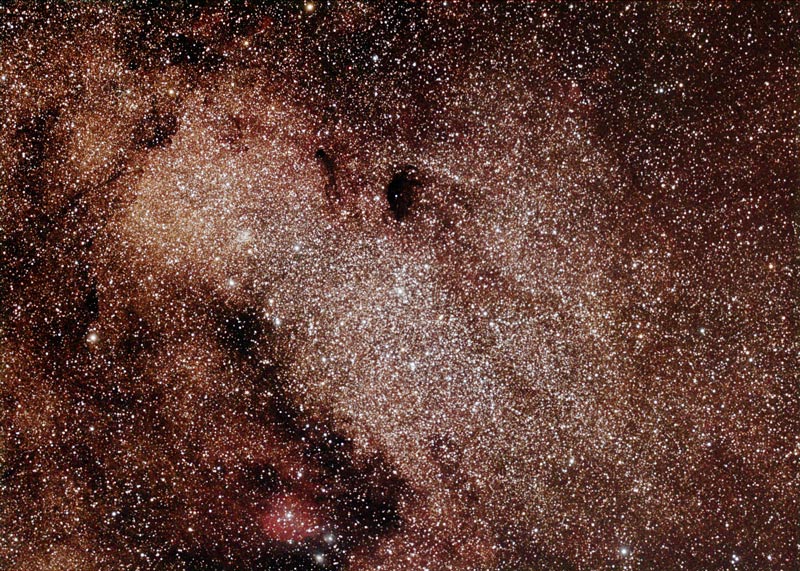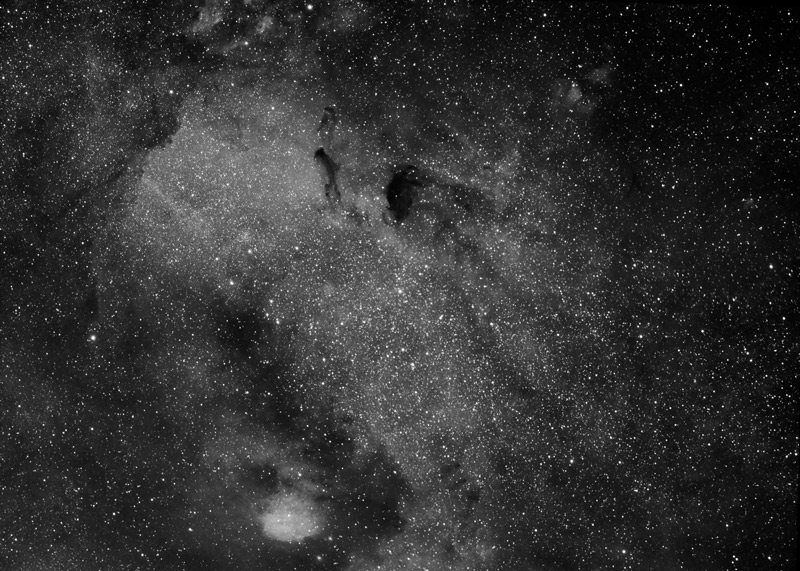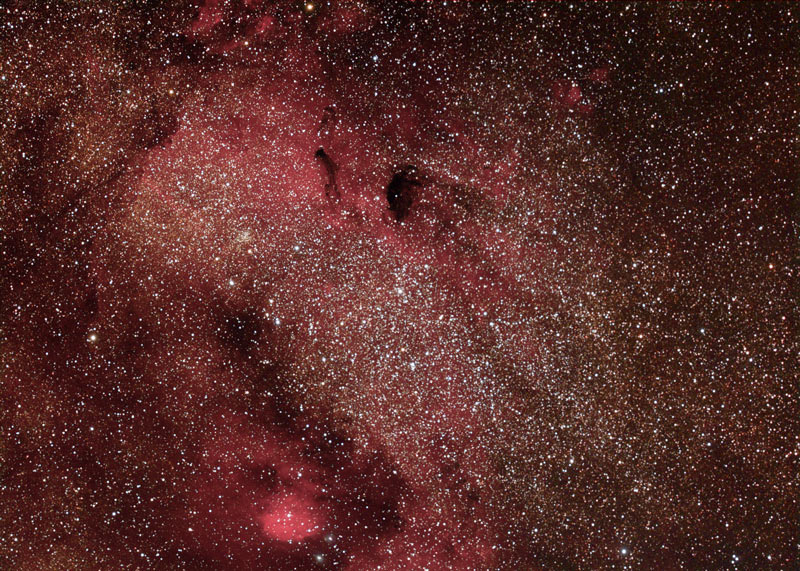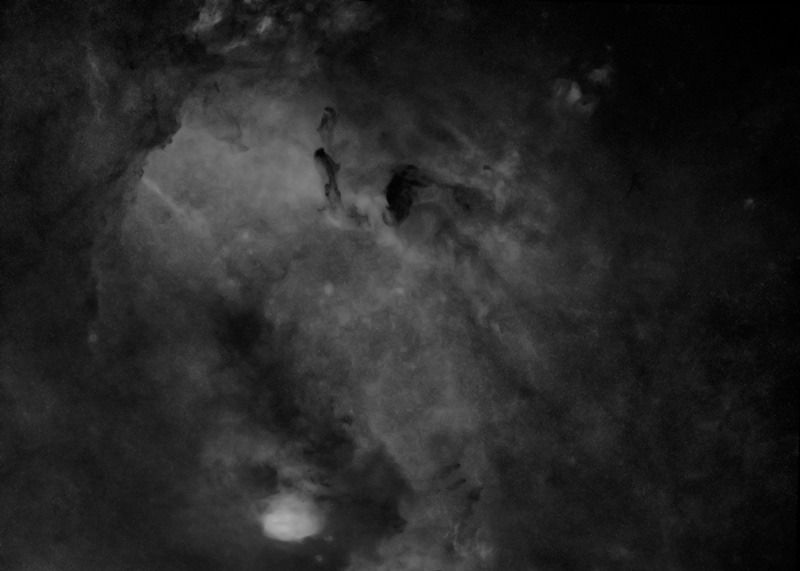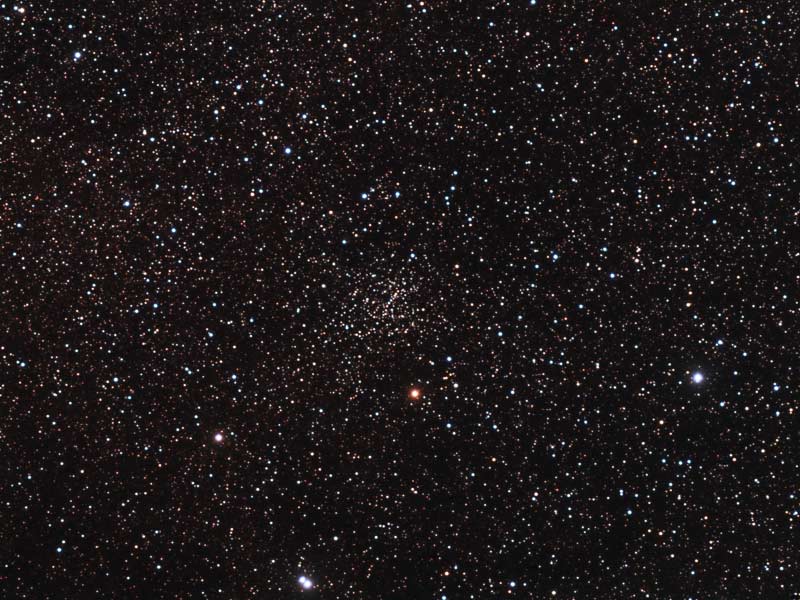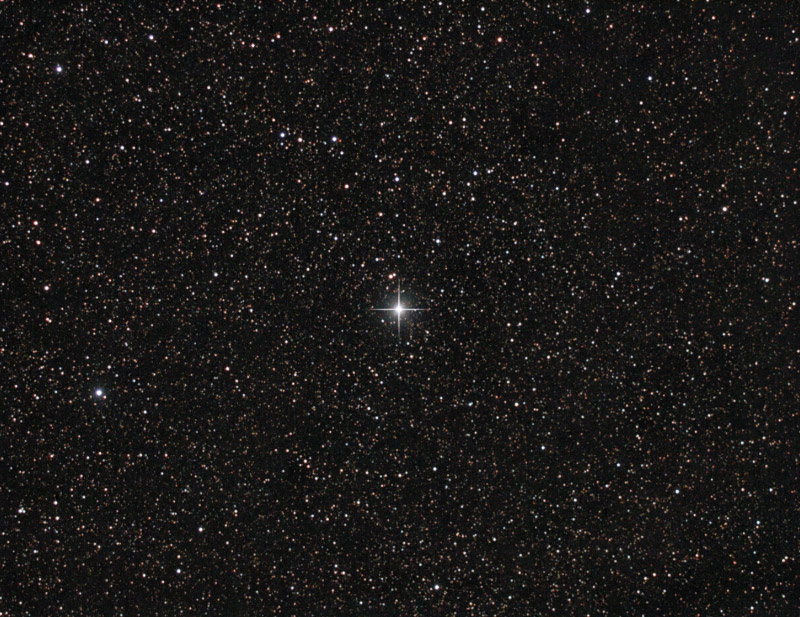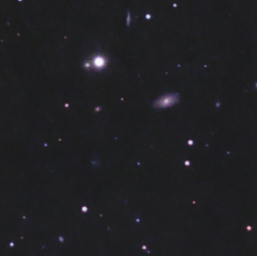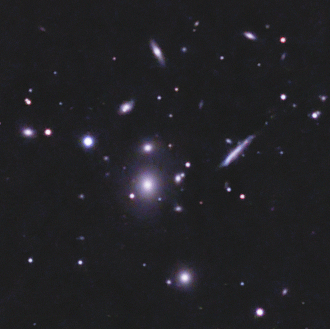North America and Pelican Nebulae
The North America Nebula is a huge emission nebula in Cygnus close to the bright star Deneb.
It took me years to see it through a telescope, even from dark skies. At 4 times the size of the full moon, i was staring right at the middle of it with my long focal length telescope. Finally i used a filter in the small low power finder scope on top and caught it.
This image is a two frame mosaic with my shortest focal length telescope, showing the North American nebula to the left, and the pelican nebula to the right of a central patch of dust.
This image uses the "hubble pallet" with high energy oxygen as blue, low energy sulfur as red, and hydrogen as green.
not entirely happy with the framing as i've clipped the west coast in order to include the pelican :(
might try again next year
Here it is with an alternative pallet using only high energy oxygen as blue and low energy sulfur as red (hydrogen was used in part as luminance):
Here's an older close up of the "cygnus wall" aka "gulf of mexico"
and the Pelican
Takahashi FS60c @255mm CS 8.6nm Ha, AD 3nm OIII, AD 3nm SII, SX H9
2 frame mosaic total time Ha 49x5 min, OIII 74x10 min, SII 92x10 min
Newport Beach, CA 10/2014
Try increasing gamma if dark sections aren't distinguished
Thursday, November 27, 2014
Sunday, November 16, 2014
Photographic Light Pollution Filter Comparison: Hutech IDAS LPS-P2 vs Chroma Loglow
Having recently moved I've noticed some improvement in my skies from bortle white to bortle "off white". At zenith on a good night, my sky quality meter reads 18.12 mag/arcsec^2. There is a red glow to the north up to an altitude of 40 degrees and a grey glow above that to 70 degrees. The sky is darker above and to the south. The milky way is impossible naked eye.
I do all my imaging from these skies with an LPS filter, narrow band filter, a combination of both. Emission nebulae are great, galaxies are difficult, but can be very rewarding (especially if there are HII regions), reflection nebulae are very difficult and dust is impossible.
As a testament to the fact that I purchase too many filters, I was given a Chroma Loglow filter to test. So I've compared it the the Hutech IDAS LPS-P2 filter which many (including me) consider the gold standard light pollution filter. A quick visual inspection showed more light passing through the Chroma than the IDAS. I initially thought the Chroma had more of a reddish cast, but realized this was on a fluorescent bulb. Searching around for an incandescent bulb yielded similar, more neutral color balance for each with perhaps a slight blue cast to the IDAS.
Iris Nebula, a reflection nebula surrounded by dust shot through heavy light pollution:
Reflection nebulae are usually blue because the scattering is more efficient for blue light than red (this is the same scattering process that gives us blue skies and red sunsets) (Wikipedia).
The black void above, below, right, and left of the nebula is caused by intervening dust. darker skies allow the glowing dust to be imaged.
Dumbbell Nebula, an emission (planetary) nebula, at maximum elevation with minimal gradients due to light pollution:
Here are the details of the filter test:
It should be noted that the filters were used on different nights, though the conditions were similar. My first target was M24, low in the south, but in the direction with least light pollution, using an FS 60C at F 4.2 and a Starlight Xpress H9C camera. The star and background signal was much higher with the Loglow, though I did not note any difference in depth or gradients in this dense star field (comparison images not shown). The seeing was slightly better when the IDAS was used. The combined image can be seen here in a prior post.
Dumbbell Nebula
Next up was M27, an excellent target, as it has strong OIII and Ha emissions transiting at zenith in an area where gradients and light pollution are minimized. Using an FS 102 at F 6, I compared a Baader IR/UV filter to the IDAS and the Loglow. There were no appreciable light pollution gradients. The nebular emission signal was enhanced relative to the stars with both the IDAS and the Loglow. I could not appreciate any significant difference between the IDAS and the Loglow. I've attempted to minimize processing to color balance and matching digital development:
IR/UV
I do all my imaging from these skies with an LPS filter, narrow band filter, a combination of both. Emission nebulae are great, galaxies are difficult, but can be very rewarding (especially if there are HII regions), reflection nebulae are very difficult and dust is impossible.
As a testament to the fact that I purchase too many filters, I was given a Chroma Loglow filter to test. So I've compared it the the Hutech IDAS LPS-P2 filter which many (including me) consider the gold standard light pollution filter. A quick visual inspection showed more light passing through the Chroma than the IDAS. I initially thought the Chroma had more of a reddish cast, but realized this was on a fluorescent bulb. Searching around for an incandescent bulb yielded similar, more neutral color balance for each with perhaps a slight blue cast to the IDAS.
Iris Nebula, a reflection nebula surrounded by dust shot through heavy light pollution:
Reflection nebulae are usually blue because the scattering is more efficient for blue light than red (this is the same scattering process that gives us blue skies and red sunsets) (Wikipedia).
The black void above, below, right, and left of the nebula is caused by intervening dust. darker skies allow the glowing dust to be imaged.
Dumbbell Nebula, an emission (planetary) nebula, at maximum elevation with minimal gradients due to light pollution:
Here are the details of the filter test:
It should be noted that the filters were used on different nights, though the conditions were similar. My first target was M24, low in the south, but in the direction with least light pollution, using an FS 60C at F 4.2 and a Starlight Xpress H9C camera. The star and background signal was much higher with the Loglow, though I did not note any difference in depth or gradients in this dense star field (comparison images not shown). The seeing was slightly better when the IDAS was used. The combined image can be seen here in a prior post.
Dumbbell Nebula
Next up was M27, an excellent target, as it has strong OIII and Ha emissions transiting at zenith in an area where gradients and light pollution are minimized. Using an FS 102 at F 6, I compared a Baader IR/UV filter to the IDAS and the Loglow. There were no appreciable light pollution gradients. The nebular emission signal was enhanced relative to the stars with both the IDAS and the Loglow. I could not appreciate any significant difference between the IDAS and the Loglow. I've attempted to minimize processing to color balance and matching digital development:
IR/UV
IDAS
Loglow
blink:
stack of 9x120 sec exposures, color balanced by eye followed by digital development in maxim.
Iris Nebula
Last was the Iris nebula, a reflection nebula surrounded by dust in the dreaded northern muck, again with the FS 102 at F6. As there appeared to be a significant color difference in the reflection component, the images were color balanced with x-calibrator. The reflection component appeared significantly more blue with the IDAS and Loglow compared to the IR/UV filter. I am not certain whether this is the result of grey light pollution contaminating the IR/UV images or enhanced color by the IDAS and Loglow due to rejection of signal in the middle of the color spectrum. In any event, I found the effect aesthetically pleasing.
IR/UV
IDAS:
Loglow:
stack of 19x5 minutes color balanced with x-calibrator, ddp in maxim.
An aggressive histogram stretch in maxim showed the worst gradient with the IR/UV and best with Loglow, though the IDAS was close.
IR/UV
IDAS
Loglow
I did shoot some luminance with the two filters, but the background signal was so high with 2 minute subs, that it reached the non-linear region of my camera, making flats ineffective. Between hot spots and dust specks it was difficult to make any comparisons.
Signal:
I compared the stellar, nebular, and background signal for a representative section of the M27 stacks and found the following:
For all of the quantities, the Lowglow had higher signal than the IDAS; the IR/UV the highest signal of all.
However, for the ratio of stellar signal to background and nebular signal to background, the IDAS had the highest ratio, followed by the Loglow, and then the IR/UV filter.
| idas | loglow | ir/uv | |
| M27 background | 1,280 | 2,230 | 2,890 |
| star | 27,777 | 27,928 | 30,110 |
| fwhm | 2.03 | 1.74 | 1.75 |
| nebula (color balanced) | 1779 | 2733 | 3388 |
| nebula (unbalanced) | 1672 | 2745 | 3400 |
| star/background | 21.70 | 12.52 | 10.42 |
| nebula/background | 1.39 | 1.23 | 1.17 |
| nebula(unbalanced)/background | 1.31 | 1.23 | 1.18 |
| iris background | 3,500 | 5,376 | 7,257 |
| iris star | 19,000 | 21,000 | 28,000 |
| fwhm | 1.68 | 1.98 | 1.76 |
| excalibrator green | 0.93 | 0.99 | 1.03 |
| excalibrator blue | 0.76 | 0.81 | 1.16 |
| star/background | 5.43 | 3.91 | 3.86 |
Takahashi Fs 102 @619 mm Hutech IDAS LPS-P2/Choroma LoGlow, Starlight Xpress H9C/H9
M 27 34x2 minutes RGB, IRIS ~100 x 2 min luminance, 84x5 min RGB
9/15-9/24/14 Neport Beach, CA
Bottom Line
The two filters were comparable in terms of reducing light pollution gradients and enhancing nebular emissions.
The LoGlow seemed to be slightly better than the IDAS-P2 in terms of light pollution gradient reduction.
The LoGlow also passed more signal while the IDAS-P2 had a higher signal to background ratio.
clear skies
Wednesday, November 12, 2014
10/23/14 partial eclipse animation
finally finished the animation of the partial eclipse in hydrogen alpha.
imaged over about two hours.
a "usb fault" caused me to miss the very beginning while trees interfered with the end.
here's the full disk animation (large file) over 2 hours:
though the sun spots were dramatic in white light, they were less prominent in hydrogen alpha at this scale.
other than the moon passing by, there was not a whole lot happening during the time period of the animation at large scale.
Here's the sunspot, AR 2192 in hydrogen alpha:
Here are 150% enlargements of two small sections that showed some activity:
Sunday, November 9, 2014
solar active region AR 12192: the monster revisited
here's a wider view of the monster sunspot grouping i caught just before the recent partial eclipse.
according to one source, this grouping, known as AR 12192 is one of the largest sunspot groupings in recorded history
fortunately, it arrived at a time when i was working on my sunspot technique and had made great strides, imaging structures i'd never been able to catch before. specifically, the honeycomb-like granular structure on the bright surface and the and the "penumbral filaments" at the edge of the dark spot (best seen around the large spot to the right).
"Granules on the photosphere of the Sun are caused by convection currents (thermal columns, Bénard cells) of plasma within the Sun's convective zone. The rising part of the granules is located in the center where the plasma is hotter. The outer edge of the granules is darker due to the cooler descending plasma." (Wikipedia)
These convection currents contribute to the sun's magnetic field.
the penumbral filaments at the edge of the dark spot aren't that well understood (at least by me). they seem to involve an interaction between magnetic fields of different orientations and convective flow.
magneto-convective cell reference
the sun rotates once every 27 days or so
will be interesting to see if this grouping comes back around.
the key to the improved image was taking a huge number of frames over a short period and discarding all but the very best. to do this i had to use a different camera with a smaller field of view and faster frame rate. unfortunately, the field of view was smaller than this large grouping.
compare the detail (especially the fine filaments) on this small high frame-rate field to the right side above:
i tried a mosaic in an attempt to get a wider field and high frame rate, but it came out to too patchy
for reference here's a prior image at the same scale:
IMAGE improvement DETAILS
the following measures gave improved images:
1. switched cameras from DMK 51 to zwo ASI120MC which allows a much higher frame rate.
-DMK is great for wide full disk animations, but limited to 12 fps-i'd misread the framerate as 60 fps-that's the output avi :(
using a partial frame with the zwo got me to an average of 54 fps which overcame the handicap of the color camera
2. much smaller stack: took only the best 20 or so images at the upward curve to the left of registax stackgraph quality indicator.
3. kept the imaging time very short--20 seconds
4. put the solar filter (baader film) on the scope inside and immediately pointed it at the sun when i brought it outside.
-the charcoal black carbon fiber tube heats up very quickly with direct sunlight. rather than insulate, i figured the film would reflect the energy immediately, keeping the tube out of direct light.
i think the biggest factor was limiting the stack size
which means i can reprocess some of my older images :)
did not recollimate
tried an off-axis mask prior to these changes with no improvement
no change in focus technique
according to one source, this grouping, known as AR 12192 is one of the largest sunspot groupings in recorded history
fortunately, it arrived at a time when i was working on my sunspot technique and had made great strides, imaging structures i'd never been able to catch before. specifically, the honeycomb-like granular structure on the bright surface and the and the "penumbral filaments" at the edge of the dark spot (best seen around the large spot to the right).
"Granules on the photosphere of the Sun are caused by convection currents (thermal columns, Bénard cells) of plasma within the Sun's convective zone. The rising part of the granules is located in the center where the plasma is hotter. The outer edge of the granules is darker due to the cooler descending plasma." (Wikipedia)
These convection currents contribute to the sun's magnetic field.
the penumbral filaments at the edge of the dark spot aren't that well understood (at least by me). they seem to involve an interaction between magnetic fields of different orientations and convective flow.
magneto-convective cell reference
the sun rotates once every 27 days or so
will be interesting to see if this grouping comes back around.
the key to the improved image was taking a huge number of frames over a short period and discarding all but the very best. to do this i had to use a different camera with a smaller field of view and faster frame rate. unfortunately, the field of view was smaller than this large grouping.
compare the detail (especially the fine filaments) on this small high frame-rate field to the right side above:
i tried a mosaic in an attempt to get a wider field and high frame rate, but it came out to too patchy
for reference here's a prior image at the same scale:
IMAGE improvement DETAILS
the following measures gave improved images:
1. switched cameras from DMK 51 to zwo ASI120MC which allows a much higher frame rate.
-DMK is great for wide full disk animations, but limited to 12 fps-i'd misread the framerate as 60 fps-that's the output avi :(
using a partial frame with the zwo got me to an average of 54 fps which overcame the handicap of the color camera
2. much smaller stack: took only the best 20 or so images at the upward curve to the left of registax stackgraph quality indicator.
3. kept the imaging time very short--20 seconds
4. put the solar filter (baader film) on the scope inside and immediately pointed it at the sun when i brought it outside.
-the charcoal black carbon fiber tube heats up very quickly with direct sunlight. rather than insulate, i figured the film would reflect the energy immediately, keeping the tube out of direct light.
i think the biggest factor was limiting the stack size
which means i can reprocess some of my older images :)
did not recollimate
tried an off-axis mask prior to these changes with no improvement
no change in focus technique
Sunday, October 26, 2014
solar selfie from 10/23/14 eclipse
why call it a silhouette when i can be trendy?
if you look around while the sun is partially eclipsed, you may notice strange things in the shadows: a blurring of the sharp line between light and dark, strange shapes in light. leaves in the trees may create a pinhole camera effect giving projections of the eclipsed sun on the ground.
i couldn't find an example in the immediate area so i made one myself ;)
I know, you're thinking that's just my first web space casting a shadow. Here's a more dramatic example i encountered indoors created by holes in the blinds:
if you look around while the sun is partially eclipsed, you may notice strange things in the shadows: a blurring of the sharp line between light and dark, strange shapes in light. leaves in the trees may create a pinhole camera effect giving projections of the eclipsed sun on the ground.
i couldn't find an example in the immediate area so i made one myself ;)
I know, you're thinking that's just my first web space casting a shadow. Here's a more dramatic example i encountered indoors created by holes in the blinds:
Thursday, October 23, 2014
eclipse preview and a monster spot
as usual, the sun has upstaged the moon, producing the largest sunspot folks have seen in years at the same time as the partial solar eclipse. it's so big folks are simply referring to it as the monster. larger than jupiter and easily visible without magnification (eclipse glasses only).
here's a section of it:
and here's the full disk in hydrogen alpha mid way through the partial eclipse:
more to follow...
here's a section of it:
and here's the full disk in hydrogen alpha mid way through the partial eclipse:
more to follow...
Sunday, October 19, 2014
solar surface animation, eclipse alert 10/23/14
OK first up
there will be a solar eclipse visible from the US on thursday 10/23/14.
http://shadowandsubstance.com/#Partial
needless to say, as it's only a partial eclipse, the sun will still be blindingly bright.
protective eye-wear or projection is a must for viewing.
not much happened in my full disk Ha animations.
close-ups of prominences however gave interesting movements.
so here are some close ups of the disk surface.
not quite as dramatic as a prominence lifting off, but still interesting.
first, here's the full field (click on image for full size):
there will be a solar eclipse visible from the US on thursday 10/23/14.
http://shadowandsubstance.com/#Partial
needless to say, as it's only a partial eclipse, the sun will still be blindingly bright.
protective eye-wear or projection is a must for viewing.
not much happened in my full disk Ha animations.
close-ups of prominences however gave interesting movements.
so here are some close ups of the disk surface.
not quite as dramatic as a prominence lifting off, but still interesting.
first, here's the full field (click on image for full size):
high contrast grey-scale
here's a circular filament around an active region:
here are what look like classic magnetic field lines from one sun spot to another:
a filament arching off the surface:
eruptions around a sun spot, which, i guess is why they're called "active regions":
imaging details:
7/5/14 newport beach, ca
DMK 51, 2.5x Powermate, Lunt 60 PT B1200
2 hours of imaging at ~12 fps every other minute
best 300 frames every minute
7.8 ms exposure
the images were spoiled by dust on the sensor
finally salvaged them by creating artificial flats
though you can still see some faint shadows of dust spots in the animations
(right side of last)
Monday, October 6, 2014
Saturn 2014
forgot to send out this year's best shot:
getting some nice color in the bands
a hint of the north polar cloud, but no hexagon
can see Cassini's division and the maybe Encke minimum
the images are taken by using a video camera, stacking thousands of short long exposures
allowing processing software to select the images least distorted by seeing
stacking thousands of images in this way gives a much more sharp image
in theory one can upsample the video by 2x to get better magnification
so i decided to do a test, comparing and upsampled image
with an image using a 2.5x barlow to give more magnification
but requiring longer exposure.
which will be better?
larger magnification with longer exposure
or shorter exposure eliminating seeing effects?
2.5x barlow:
upsampled 2x:
though the seeing wasn't really sufficient for either
getting some nice color in the bands
a hint of the north polar cloud, but no hexagon
can see Cassini's division and the maybe Encke minimum
the images are taken by using a video camera, stacking thousands of short long exposures
allowing processing software to select the images least distorted by seeing
stacking thousands of images in this way gives a much more sharp image
in theory one can upsample the video by 2x to get better magnification
so i decided to do a test, comparing and upsampled image
with an image using a 2.5x barlow to give more magnification
but requiring longer exposure.
which will be better?
larger magnification with longer exposure
or shorter exposure eliminating seeing effects?
2.5x barlow:
compare the Encke minimum and colored bands
close, but i think the barlow winsthough the seeing wasn't really sufficient for either
Sunday, September 21, 2014
saturn overview
Saturn
6th planet from the sun, second largest after jupiter
a gas giant
it has a slight yellowish color due to ammonia in the upper atmosphere
with faint bands (much less dramatic than jupiter's)
and...
first view of saturn through a telescope:
unknowingly, i pointed the scope at a bright "star" rising in the east
and was shocked to see it had rings...
a shudder and a concrete sense that there really is more out there than we know.
there's something about the rings and the shadow they cast over the sphere that makes it appear much more like a perfect 3-dimensional structure than a simple disk.
the gap in the rings is called the Cassini division.
the darker band outside the cassini division is called the Encke minimum.
there's a near mythical gap outside of that called the Encke division.
that is only visible from earth with under excellent seeing conditions with high quality optics.
the angle of the rings varies from year to year as saturn makes its 29.5 year orbit around the sun.
in 2002 they were maximally tilted with the south pole facing us
(about the time i bought my largest scope)
here's one of my earliest shots from 2004:
i found the iconic line made an interesting image:
there's something special about the north pole:
santa's helpers must be more mischievous on saturn
i've yet to see or image it, but as the north pole continues to tilt
towards us i'm hoping to catch it
saturn has 150 moons and counting
the largest, titan, is larger than mercury and contains it's own atmosphere as well as hydrocarbon lakes.
titan casting shadow on saturn's surface:
enceladus is notable for salt water geysers which contribute to saturn's rings
more on saturn:
http://solarsystem.nasa.gov/planets/profile.cfm?Object=Saturn
http://www.nakedeyeplanets.com/saturn-orbit.htm
http://www.astronomycast.com/2007/10/episode-59-saturn/
http://www.astronomycast.com/2014/05/ep-344-the-rings-of-saturn/
http://www.astronomycast.com/2007/11/episode-61-saturns-moons/
http://en.wikipedia.org/wiki/Saturn%27s_hexagon
6th planet from the sun, second largest after jupiter
a gas giant
it has a slight yellowish color due to ammonia in the upper atmosphere
with faint bands (much less dramatic than jupiter's)
and...
IT HAS RINGS!
first view of saturn through a telescope:
unknowingly, i pointed the scope at a bright "star" rising in the east
and was shocked to see it had rings...
a shudder and a concrete sense that there really is more out there than we know.
there's something about the rings and the shadow they cast over the sphere that makes it appear much more like a perfect 3-dimensional structure than a simple disk.
the gap in the rings is called the Cassini division.
the darker band outside the cassini division is called the Encke minimum.
there's a near mythical gap outside of that called the Encke division.
that is only visible from earth with under excellent seeing conditions with high quality optics.
the angle of the rings varies from year to year as saturn makes its 29.5 year orbit around the sun.
in 2002 they were maximally tilted with the south pole facing us
(about the time i bought my largest scope)
here's one of my earliest shots from 2004:
in 2009, they were edge-on
though many find this the worst time to view saturni found the iconic line made an interesting image:
the rings are now opening again
peaking in June 2017 with the best view of the rings and the north pole of the planet (this event will sell lots of telescopes ;)there's something special about the north pole:
the dark patch at the north pole is actually hexagonal!
it is a persistent cloud pattern, similar to jupiter's great red spotsanta's helpers must be more mischievous on saturn
i've yet to see or image it, but as the north pole continues to tilt
towards us i'm hoping to catch it
saturn has 150 moons and counting
the largest, titan, is larger than mercury and contains it's own atmosphere as well as hydrocarbon lakes.
titan casting shadow on saturn's surface:
9 or 10 can be seen thru an amateur telescope
enceladus is notable for salt water geysers which contribute to saturn's rings
more on saturn:
http://solarsystem.nasa.gov/planets/profile.cfm?Object=Saturn
http://www.nakedeyeplanets.com/saturn-orbit.htm
http://www.astronomycast.com/2007/10/episode-59-saturn/
http://www.astronomycast.com/2014/05/ep-344-the-rings-of-saturn/
http://www.astronomycast.com/2007/11/episode-61-saturns-moons/
http://en.wikipedia.org/wiki/Saturn%27s_hexagon
Saturday, September 6, 2014
M 24, it's full of stars
"my God it's full of stars"
the patch of red, suggested there was some glowing hydrogen in the surrounding gas, so i decided to shoot it with an Ha filter:
Here's a combined view:
interestingly i see an Ha wall along the upper right margin of the star cloud
that is more evident in the HaRGB than the Ha itself.
if it weren't full of stars it would look like this:
Lastly here's a close up of the open cluster in the upper left portion of the star cloud i shot a few years ago:
-bill w
image details:
FS 60c @ 254 mm 5.23"/px full size
field approximately 2.5x3.5 degrees
Hutech IDAS, Chroma Loglow, Astrodon 5nm Ha filters
SX H9C, ASA DDM 60 unguided
4 panel mosiac composed of approximately 17 5 minute subs RGB
15 5 minutes subs Ha
7/21-8/17/2014
newport beach, ca
more than you wanted to know about 2001:
http://www.filmsite.org/twot.html
http://c2.com/cgi/wiki?MyGodItsFullOfStars
-Dave Bowman's final words prior to entering the monolith in 2001: a space odyssey. contrary to my recollection, the line occurred only in the book version, not the movie, but was grafted into the movie as a flashback in the opening of 2010.
Messier object 24, a/k/a the sagittarius star cloud, isn't really a star cluster, it's just a bright patch of stars in the milky way surrounded by dust. it can be thought of as a hole in the dust, allowing us to see much deeper towards the center of our galaxy. (no frank, you can't see the black hole). The bright patch can be seen with the naked eye in skies dark enough to see the milky way as a bright patch above sagittarius
Here's a combined view:
interestingly i see an Ha wall along the upper right margin of the star cloud
that is more evident in the HaRGB than the Ha itself.
if it weren't full of stars it would look like this:
Lastly here's a close up of the open cluster in the upper left portion of the star cloud i shot a few years ago:
-bill w
image details:
FS 60c @ 254 mm 5.23"/px full size
field approximately 2.5x3.5 degrees
Hutech IDAS, Chroma Loglow, Astrodon 5nm Ha filters
SX H9C, ASA DDM 60 unguided
4 panel mosiac composed of approximately 17 5 minute subs RGB
15 5 minutes subs Ha
7/21-8/17/2014
newport beach, ca
more than you wanted to know about 2001:
http://www.filmsite.org/twot.html
http://c2.com/cgi/wiki?MyGodItsFullOfStars
Thursday, September 4, 2014
Delta Aquilae is 50 light years away
Aquila, the eagle, is a summer constellation.
It can be found here in the summer evenings section:
It’s brightest star, alpha aquilae, a/k/a altair, forms one of
the corners of the summer triangle. A
huge right triangle seen overhead during summer nights.
Delta aquilae is at the center of the eagle. At visual magnitude 3.36 it can be seen with
the naked eye in good viewing conditions.
It is 50 light years away.
Einstein’s theory of special relativity. Basically states that the speed of light is
the same for all observers. Consider a
space ship moving away from us at half the speed of light. We shine a bright pulse of light into
space. After a year the light has
traveled one light year away from us, while the space ship has traveled half a
light year. The pulse of light is half a
light year from the ship. So if the
light has only traveled half a light year from the ship, how can its speed relative
to the ship be the same? Speed=distance/time. So the solution is that the ship has only
experienced half the time we have on earth—time has slowed down.
Consider a photon leaving delta aquilae 50 years ago. Some of us have experienced 50 years waiting
for its arrival today. But the photon,
traveling AT the speed of light experienced no time at all.
Something to think about for this day.
Imaging details.
FS 60c @ 254 mm 5.23"/px full size
Chroma Loglow filter
SX H9C, ASA DDM 60 unguided
13 5 minutes, 24x30s, 24x3s
Chroma Loglow filter
SX H9C, ASA DDM 60 unguided
13 5 minutes, 24x30s, 24x3s
"diffraction spikes" added in processing for emphasis
newport beach, ca
newport beach, ca
Wednesday, August 20, 2014
Leo Galaxy Cluster aka Abell 1367: Part 3 quasars and cosomology
Caught a number of background quasars in the field of Abell 1367.
quasars (quasi-stellar radio sources)
look like faint blue stars
but they have *very* high red-shifts
which made them somewhat of a mystery
turns out they are actually extremely distant galaxies
with black holes that are actively feeding on matter
generating massive amounts of light.
though light cannot escape the black holes,
energy is generated just outside the event horizon
by massive gravitational stresses and friction acting on the incoming material.
the most distant quasar in the image
(blue dot just below the S in QSO lower left)
quasars (quasi-stellar radio sources)
look like faint blue stars
but they have *very* high red-shifts
which made them somewhat of a mystery
turns out they are actually extremely distant galaxies
with black holes that are actively feeding on matter
generating massive amounts of light.
though light cannot escape the black holes,
energy is generated just outside the event horizon
by massive gravitational stresses and friction acting on the incoming material.
the most distant quasar in the image
(blue dot just below the S in QSO lower left)
has a red shift (Z) of 3.36:
recall that the redshift of the galaxy cluster 330 million light years distant was 2.3% or .023
the QSO's red shift is 3.36 or 336%!
so how far away is it?
well here's where things get *relatively* slippery
the universe is expanding
it's taken light a really long time to reach us from this object
do we want to know how far away it is now or how far away it was when the light left the galaxy?
when it left the galaxy, our planet, solar system and sun didn't exist.
now, due to the expansion of the universe, the galaxy is moving away from us faster than the speed of light
it's current distance can never be observed
dirty cosmology trick:
nothing can move through space faster than the speed of light
but the universe itself can expand faster than the speed of light
(my head hurts)
the commonly used figure is
light travel time
which is neither where it is now, nor where it was when it emitted the light
but a measure of how long it took the photons to reach us
it gets even worse:
redshift versus distance is not linear for large distances
so in order to calculate the distance
theoretical models with various parameters including the shape of the universe!
have to be used
best estimates for the parameters change over time
...so by one of the more commonly used estimates*, this one is
11.8 billion light years away
the big bang happened 13.7 billion years ago
the universe was a lot smaller place when light left this object
here's another small crop from the center of the image
including the Ha emitting galaxy from last time
with 3 quasars (distance in billions of light years):
interesting cosmological explanations (laymen's terms):
life the universe and everything
(be sure to mouse over the answer)
Ned Wright's FAQ on cosmology and the big bang
*Ned Wright's Cosmology Calculator
recall that the redshift of the galaxy cluster 330 million light years distant was 2.3% or .023
the QSO's red shift is 3.36 or 336%!
so how far away is it?
well here's where things get *relatively* slippery
the universe is expanding
it's taken light a really long time to reach us from this object
do we want to know how far away it is now or how far away it was when the light left the galaxy?
when it left the galaxy, our planet, solar system and sun didn't exist.
now, due to the expansion of the universe, the galaxy is moving away from us faster than the speed of light
it's current distance can never be observed
dirty cosmology trick:
nothing can move through space faster than the speed of light
but the universe itself can expand faster than the speed of light
(my head hurts)
the commonly used figure is
light travel time
which is neither where it is now, nor where it was when it emitted the light
but a measure of how long it took the photons to reach us
it gets even worse:
redshift versus distance is not linear for large distances
so in order to calculate the distance
theoretical models with various parameters including the shape of the universe!
have to be used
best estimates for the parameters change over time
...so by one of the more commonly used estimates*, this one is
11.8 billion light years away
the big bang happened 13.7 billion years ago
the universe was a lot smaller place when light left this object
here's another small crop from the center of the image
including the Ha emitting galaxy from last time
with 3 quasars (distance in billions of light years):
interesting cosmological explanations (laymen's terms):
life the universe and everything
(be sure to mouse over the answer)
Ned Wright's FAQ on cosmology and the big bang
*Ned Wright's Cosmology Calculator
Subscribe to:
Posts (Atom)




